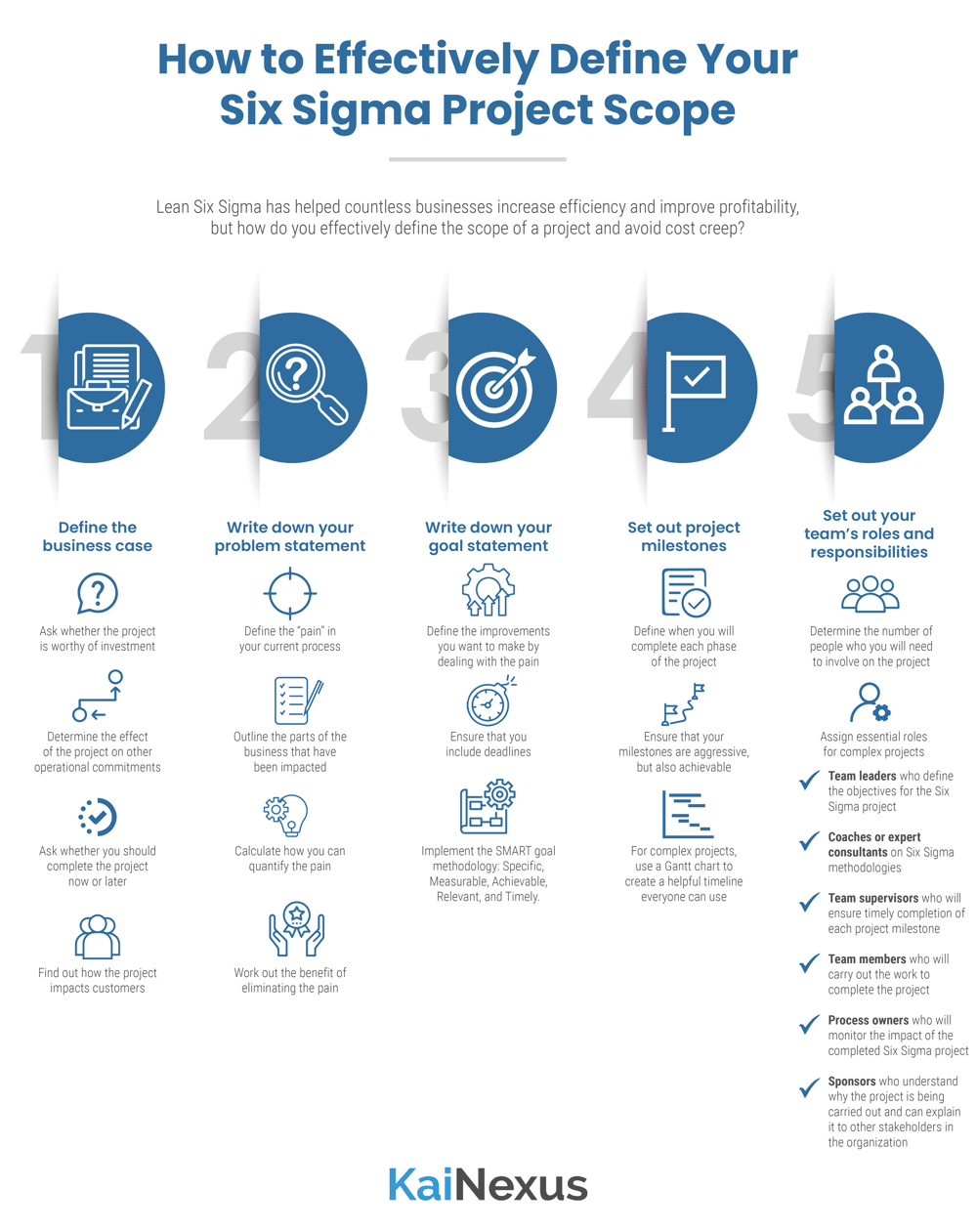 Lean Six Sigma is a business optimization methodology that combines two popular continuous improvement methods, Lean and Six Sigma. These well-proven approaches give organizations a structured path to reaching their strategic goals quickly and profitably.
Lean Six Sigma is a business optimization methodology that combines two popular continuous improvement methods, Lean and Six Sigma. These well-proven approaches give organizations a structured path to reaching their strategic goals quickly and profitably.
While the driving force behind Lean Six Sigma is daily incremental improvement, implemented by employees at every level of the organization, it often involves discrete projects targeted at specific problems or goals. Therefore, defining the scope of each project is critical for both project success and ongoing measurement of the results.
5 Types of Six Sigma Projects
Six Sigma practitioners categorize projects into one of five buckets:
Quick Wins: Quick wins represent the implementation of simple solutions to solve known issues. Generally, these problems are confined to a single department. The root cause of the matter is well understood, and the fix is painless. Sometimes these projects are called “Just-Do-It” or fast track.
Process Improvements: Process improvements result in an incremental reduction of defects, cost, or cycle time. In this case, the pro problem has an unknown cause, and the solution is unknown at the outset. Sometimes this group of improvements is referred to as a DMAIC or PDSA project.
Process Design: Process design involves the creation of a brand-new process. There is no existing process to analyze for benchmarking. This type of project might be referred to as DMADV (Define—Measure—Analyze—Design—Verify) or DFSS (Define for Six Sigma).
Process Redesign: This type of project is about a complete overhaul of non-capable, existing processes. In this case, the process exists, but incremental improvements are not enough to generate acceptable results or satisfy customer requirements. Sometimes these projects are referred to as reengineering.
Infrastructure Implementation: Infrastructure implementation Six Sigma projects establish key measurement systems. They often involve the monitoring of process capabilities and establishing the voice of the customer. Another name for these projects is process management.
The specificity of the project scope varies by type. The more complex the project, the more critical it is to define and communicate the scope. But in any case, it is helpful to consider the following elements of the project scope.
Components of a Six Sigma Project Scope
Business Case
Defining the business case helps project sponsors and team members understand how the project is tied to the overall strategic goals of the business. It explains a requirement for the organization to engage in the project and how it will support annual or long-term objectives.
The business case answers the following questions:
- Why is this project worth the investment of necessary resources?
- How does this project impact customers?
- Why does the problem to be solved matter to the business?
- Why is this project meaningful for employees?
- Why should we do it now?
- What would happen if we didn’t do this project now?
- Which operational objectives does this project support?
An example business case might be, “By reducing the average hold time of calls to the contact center, we will increase customer satisfaction, reduce the number of customers who cancel their service, reduce stress on contact center employees, and prevent overload during the upcoming holiday season.”
Problem Statement
The next element is the problem statement, also known as the “Define” phase, which quantifies the pain in the current process. It answers the following questions:
- What is the measurable pain?
- What parts of the organization are impacted?
- Is the pain current, and how long has it been going on?
- How can we quantify the extent of the pain?
The problem statement is not about assigning a cause or blame, nor does it include a solution. Instead, it is focused solely on the pain caused by the current situation.
An example problem statement is, “During the last three months, average hold times in the contact center have increased by 50%, service cancellations have increased by 15%, and transactional satisfaction scores are down by 25%. Despite robust customer acquisition, revenue growth is stagnant.”
Goal Statement
The goal statement lays out what the improvement team hopes to accomplish with this project. It always starts with a verb and does not presume a cause or solution. Goal statements should include a deadline. The best goals are SMART (Specific, Measurable, Achievable, Relevant, and Timely.)
In our contact center example, the goal statement might be, “To reduce average hold times from 7.4 minutes to under 3 minutes by the end of the quarter.”
Project Milestones
Project milestones specify the timelines for completion of each phase of the project with defined deliverables. It represents a starting point for the project plan with dates tied to the stages of the DMAIC process. It should be aggressive but realistic enough to allow for proper attention to each step. Often it is accompanied by a Gantt chart and a detailed communication plan.
Roles and Responsibilities
Part of crafting a Six Sigma project scope is laying out the roles and responsibilities. Again, the number of people who need to be involved will vary depending on the project type, but for complex projects, it is helpful to fill the following roles:
Team Leadership: Project leaders define the goals and the objectives in a six sigma project.
Sponsors: They are the people who understand the reasons for the project and are dedicated to its successful implementation. They have the authority to remove obstacles that might occur during the process.
Implementation Leaders: These are the people who are responsible for supervising the team. They support the leaders by ensuring timely completion of each element of the project and provide effective communication.
Coaches: The coach is an in-house experienced expert or consultant in Six Sigma. The coach helps sets a schedule for the team and resolve any conflicts that crop up.
Team Members: Team members are the people who work on a six sigma project. They have specific responsibilities and work collectively with other team members.
Process Owners: The process owner is responsible for managing and monitoring the impacted process after the Six Sigma project is complete.
Once all these elements are in place, you have a well-defined project scope. While it is a significant planning effort, the success of your Six Sigma projects rests on this essential work.





Add a Comment